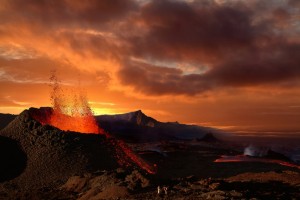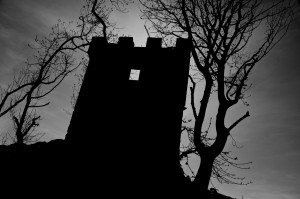2008-2024
The end of the world as we know it?
(Note that this feature was written in 2006 and first published in Wellspring Astrolog in 2007)
Lord of the Underworld, Pluto is the repository of the secrets of life and death. The Underworld is a dark place; the fount of human depravity; cruelty, torture, murder, greed, evil and violence. Its power is intense and relentless.
The planet named for this dark entity travels the zodiac in a slow elliptical orbit of 248 years, spending anywhere from 13 to 30 years in each sign of the zodiac. On 26 January 2008 Pluto leaves Sagittarius and crosses a pivotal threshold moving into Capricorn. This is an epic time that portents dramatic upheaval.
While Pluto has been moving through the freedom loving and spiritual sign of Sagittarius, we have seen these dark forces given wide scope and free rein. We have witnessed widespread terrorism, and the war waged against it; a war without borders. Torture has become an accepted practise and people have been imprisoned without trial. We have also seen an upsurge in fundamentalist religions. God, it seems, is always on “our side”, and it’s always other people, never ourselves, who are the evildoers.
Pluto’s power, as expressed through Capricorn, is likely to be far more contained and focused. Saturn, Capricorn’s ruler, is the Lord of Time. Alarm bells are sounding. We are starting to wake up. Time is ticking by more loudly.
Perhaps we should pause for a moment to consider our own personal role in all the “evils” of the world. How do our actions contribute to greed, violence, intolerance, and the destruction of our planet?
Like it or not, we are on the threshold of a tremendous transformation, a huge reality check. We “civilised” humans have greedily fed upon the resources of our earth and in the process have laid waste to it. Now we must take stock. Reform, or perish. It’s not only big business and governments that must heed Pluto’s message, now we must all face up to our perilous situation.
At this intersection we are being called to a halt. The traffic signals have changed to red giving us a moment to think. At this crossroad it’s time to stop playing the broken record called the “blame game”.
How do our own individual actions (and inactions) contribute to the destruction of the planet? Why do we flush our forests down the toilet? How do our choices at the supermarket contribute to the enslavement of others and the extinction of flora and fauna?
If a multi-national inflicts human rights abuses on their workers, or destroys an entire eco-system, why do we still buy shares in their company, or continue to work for them? Where is our superannuation invested? Do we really have to think about these things? Do we have time? How much time do we really have? Can we afford to pay the price for changing our infrastructure so that we can live a sustainable world? What will be the cost if we don’t?
Taking personal responsibility means we take power away from those who would abuse it. Naturally, there are things in life where we remain powerless to exert any influence, but there is a lot that each individual can do. Are we willing to do it? The real power lies within each of us.
Solstice Point
The mountains are the realm of Saturn and Capricorn. It’s between Pluto’s Underworld and Saturn’s peaks that humanity resides. It is here, in our earthly material reality, in the halls of civilisation, within the strata of government and business, where Pluto’s power will unfurl.
The start of Capricorn is the solstice point, where each year the Sun reaches its most southerly aspect, before heading north once more. In the southern hemisphere this is summer’s longest day, and in the northern hemisphere, winter’s shortest day.
Traditionally, Capricorn is associated with the winter solstice, a barren time of darkness. Pluto’s passage through Capricorn is a low point in the natural cycle, a time for withdrawal, inward focus and hibernation.
Coming a year or so after Pluto’s “downgrade” from planetary status, this cycle portents the intensification of the extremes of heat and cold that we normally encounter at the time of the solstice. As climate change bites down hard, Pluto reminds us just how powerful he really is, regardless of what we may think about his rank in the planetary hierarchy.
This process is likely to be felt acutely within our centres of government and most powerful institutions. Which monoliths of today’s world will be destroyed, or transformed? We may be dealt some harsh realities, in particular the fact that the earth’s resources are rapidly being depleted. As Capricorn is an earth sign, related to matter and form, many of the systems and structures of our world will undergo a revolution; indeed our ultimate survival depends on it.
This powerful energy may also be released in the form of earth changes, such as volcanic eruptions and earthquakes. If history is any guide, the effects are likely to be far reaching.
Carl Jung was of the view that destructive ‘shadow material’ erupts when the unconscious is not honoured, not given room to function, or is suppressed. When we are constantly on the go and the conscious mind is crammed full of processing day-to-day activity, there is a subsequent ignorance of inner life and an imbalance results. Jung felt that this accumulated shadow material erupts in destructive events such as war, or genocide.
Sustained ignorance of one’s inner life, a lack of introspection and self-awareness, could therefore conceivably fuel these dark episodes, and even spawn massive disasters that arrive direct from nature.
But as more and more people take personal responsibility for changing their own lives, honouring the unconscious, and doing what they can to change those aspects of our world that are crying out for reform, we may well mitigate some of the looming hardships that now seem inevitable.
Although Pluto is associated with a host of dark images and themes, through its action comes a spiritual richness, an acknowledgement of our vulnerability and common humanity. Death and suffering brings people together. Although an encounter with Pluto often means that we must confront painful and fated events, ultimately it is associated with rebirth and renewal. The cycle of life continues.
Pluto in Capricorn |
| 532-551 CE |
| 778-796 CE |
| 1024-1041 CE |
| 1269-1287 CE |
| 1516-1533 CE |
| 1762-1778 CE |
| 2008-2024 CE |
The History of Pluto in Capricorn
532-551
Dark Ages
A recent scientific examination of tree rings from across the world, along with ice core samples from the Arctic and Antarctic regions, shows that our planet experienced an extremely cold period that began around 535 CE, which lasted perhaps twenty years or more.
This period has been called the “Dark Ages” because of the collapse of culture that took place at that time, but recent research has revealed that it was literally “dark” for the sun had stopped shining. Crops failed, famine and plague spread. The population of our planet would have had no idea what was happening, nor would people have known if the climate would return to normal. Superstition flourished. Empires fell as Barbarian hordes swept cultured civilisations aside.
This was the time of the Celtic legend of Arthur, a story set against the backdrop of a wasteland. In order to restore the land (and King), Arthur’s knights searched for the Holy Grail. Such is the mythic power of this tale that it continues to fascinate us to this day.
There is very little recorded history from this time. David Keys spent many years searching for the cause and effects of this disastrous climate change. In his book Catastrophe[1], which was also made into a television documentary, Keys explains that this extended cold period altered the course of history.
Keys asserts that the most likely cause of the “Dark Ages” was an enormous eruption of Krakatoa that blocked the sun’s rays resulting in a mini-ice age. This eruption (which it is thought was so powerful that it split one land mass in two, creating the islands of Java and Sumatra) had immense social and political consequences across the globe.
Pluto entered Capricorn in February 532 CE, symbolising the destructive volcanic forces that were literally released from the “Underworld” as Krakatoa exploded. It is interesting to note that Neptune was then located in Aquarius, as it is today.
Now we are again facing the potential for a global climatic catastrophe that transforms civilisation. Many analysts agree that the financial cost of climate change could bring about a world economic depression the likes of which we have never seen. Will we have to endure a similar global catastrophe as happened in the Dark Ages and will this be a natural disaster, or one of our own making?
778-796
Charlemagne
The political balance of Europe was restructured at this time when Charlemagne, leader of the Franks (current day France and Germany) rose to power. He conquered many tribal cultures across Europe and converted people to Christianity. In 800 he became the first ruler to unite Western Europe, both religiously and politically, since the fall of the Roman Empire and the Dark Ages. Charlemagne founded the Holy Roman Empire, which would last one thousand years, although its power was reduced during the 16th Century Reformation, when Pluto was also in Capricorn. Now perhaps a new kind of “Empire” or powerful leader will emerge, one that will alter the course of history.
1024-1041
Norse culture spread at this time. This was largely due to a period of global warming. The Vikings (who had been raiding Ireland and England in the 778-796 period) now settled in Greenland. The population of Europe also grew. With a warmer climate, came an increase in trade leading to more prosperity.
The Vikings were known for their incredible fighting spirit. They did not fear death, for after death they believed that their bravest heroes went to Valhalla, where they again would do battle with courage. Endowed with supernatural strength, Thor was the Norse god of Thunder. Mountains would crumble as he approached. Two goats drew his chariot across the sky. When hungry, Thor would eat his goats and afterwards use their bones to restore them back to life with his hammer, which was imbued with both creative and destructive power. He fought against many giants and eventually slew the Great Serpent, only to drown in the Serpent’s venom. These symbols and themes (goats, mountains, serpents, rebirth, creation and destruction) are also those associated with Pluto and with Capricorn. Will we remain stuck between Saturn’s rock and Pluto’s hard place? Will we find within ourselves some of Thor’s strength and courage?
The History of Banking
In the year 1024 the Chinese were the first to use paper currency. In Europe, goldsmiths began keeping other people’s gold and silver in their vaults, giving their clients a receipt in return. These paper receipts were traded and used as currency. The goldsmiths soon noticed that only a few depositors ever wanted their gold at the same time, so they began making loans, for which they earned interest.[2] This evolved to today’s banking system.
Today, debt has reached unsustainable levels. We could now see the widespread overhaul of economic systems, and the potential collapse of some financial institutions, or stock markets. Will the imbalance in the distribution of wealth lead to revolutions or uprisings, or will there be even starker divisions between rich and poor? Will we be somehow forced to start living within our means, or will greedy corporations continue to pillage our planet’s resources even as they become depleted? Will we experience a period of global recession, or even depression?
1269-1287
Invading Mongols conquered China and founded the Yuan dynasty in 1279 under Kublai Khan. In 1275 Marco Polo set off on his trip to China, establishing new trade routes between east and west. Today China is growing as a world power. Their economy is booming. In the most populated nation on earth, just as in the rest of the world, there is a widening gulf between rich and poor. Human rights continue to be an issue. In this coming cycle will the global balance of power continue to shift from west to east and what are the implications of this? Will we witness events that curb the spiralling population on earth and if not, how will the earth itself be able to provide enough for us to all survive and prosper?
Meanwhile in Europe, power struggles within the Holy Roman Empire led to the establishment of the Habsburg dynasty. This powerful dynasty ruled until 1918, reaching its peak under Charles V, during the next cycle of Pluto in Capricorn.
1516-1533
Empires and Conquest
This cycle of Pluto in Capricorn was one of the most pivotal periods in the course of human history. Lured by gold, Spanish invaders under the leadership of Cortez destroyed the Aztec Empire. A few years later in 1532 the Spanish commander Pizarro overran the Inca Empire. Spain also began their conquest of the Mayans at this time. The Spanish stole vast quantities of gold from the Americas, which helped establish Spain as one of the most powerful of all empires.
The Ottoman Empire also reached the zenith of its power under Suleiman I. He was among a number of prominent leaders to emerge in this era, including Charles V, King of Spain and Holy Roman Emperor (1519-1556), Francis I of France (1515-1547) and Henry VIII of England (1509-1547).
Reformation
In the 16th Century the Catholic Church was the most powerful of all institutions, whose leaders were often corrupt. Throughout the entire transit of Pluto in Capricorn from 1517 to 1533, history was to witness the collapse of the authority of Rome. The Medici Family, wealthy patrons of the arts (who commissioned many masterpieces by Michelangelo) lusted for power. Several members of the Medici family held powerful positions, including that of Pope, but greed was to be their undoing.
Martin Luther set the Reformation in motion when in 1517 he challenged the authority of the Catholic Church by nailing his 95 complaints to a church door in Wittenberg, Germany. Pope Leo X’s extravagance (he regularly held 65 course banquets[3]) was quickly emptying the Vatican’s coffers.
As a result of dwindling funds, and ostensibly to raise money for the refurbishment of St Peter’s Basilica in Rome, Pope Leo X introduced a scheme of selling “indulgences” to remit sins. This was the final outrage that led to Martin Luther’s theses of complaint, which in turn sparked a political and religious revolution; the Reformation.
Pope Leo X and his cousin Pope Clement VII enraged the people to such an extent that by 1527 Rome would be overrun by invading Germans who sacked Rome.
When Pope Clement VII fled, he melted down all the gold artefacts and took as much as he could with him. His last commission to Michelangelo was to become the artist’s Last Judgement, a rather symbolic representation of the mood of the times. Pope Clement died in 1534 marking the end of an era.
During the 1517-1534 period the English Reformation saw Henry VIII establish the Church of England, breaking with Rome in order to marry Anne Boleyn.
From 1517-1521 Neptune was once again located in Aquarius. Will we soon witness another kind of “Reformation” that roots out corruption and fundamentally alters some of the world’s most powerful institutions?
1762-1778
Colonial Era
The last time Pluto was moving through Capricorn spanned the years 1762-1778 when the American Revolution took place, then came their Declaration of Independence.
In France, Marie Antoinette married Louis XVI in 1770. Coming to the throne in 1774, the French King and Queen were highly unpopular because of their extravagance and lack of skill in managing the French economy. The stark divisions between rich and poor would lead to the French Revolution.
Meanwhile, European colonial power reached new heights. Britain took control of India by means of the East India Company, and marched into Canada in 1763. The French seized much of Polynesia and Captain Cook’s arrival in Australia would lead to the destruction of another indigenous population by invading Europeans. Though slavery was outlawed in Britain in 1772, the African slave trade increased dramatically in this era, particularly throughout the southern states of the US. Africa was relentlessly plundered, as white people projected their own unseen dark side onto the so-named “dark continent”.
Industrial Revolution
In the same year that the world witnessed a rare transit of Venus within a few hours of a solar eclipse (1769), James Watt’s new steam engine escalated the pace of the Industrial Revolution. The burning of coal began on a massive scale. Now we are set for a new kind of Industrial Revolution, as obsolete and environmentally damaging technologies are overhauled and replaced by new systems that are sustainable.
With the Industrial Revolution came massive growth in business and banking. Important developments in the business world included the first building society in the Midlands in 1775 and in 1773, London’s first dedicated stock exchange. A new system of corporate ownership meant there was less government regulation in business. This led to increased competition. In 1776, Scottish economist, Adam Smith published his Inquiry into the Nature and Causes of the Wealth of Nations, which was the first attempt to study industry and commerce. This work laid the foundation for modern day economics. Now we must adopt a new economic model to take us forward into a sustainable future. Will new regulations come into force to curb the power of the multi-nationals?
2008-2024
Ageing Population
Apart from environmental degradation and climate change, a number of other pressing issues must now be faced. In many countries, including Australia, our ageing population is predicted to cause economic problems. Low birth rates combined with longevity have led to a demographic shift of enormous proportions that is set to bite our hip pockets as Baby Boomers (Pluto in Leo generation) begin to retire from the workforce.
In late 2004 economists predicted that in Australia alone, the shortfall in tax will be somewhere in the order of 2.2 billion dollars by the middle of the 21st century.[4]
While people in the third world are starving, corporate executives reap millions in salary packages and payouts. Pluto in Capricorn may signal a financial revolution that redresses this imbalance.
West vs. East – Living beyond our means
Economically, China and India are booming. The balance of global power will likely continue to accelerate away from the west in favour of Asian nations. But this boom means we are using more of the earth’s resources, especially fossil fuels such as coal and oil, adding to the effects of global warming.
In 2023-2024 Pluto will return to the location it occupied when the US was founded. This is likely to be a critical time for the US, especially for their economy.
This Pluto return sounds a karmic note. The US is the most powerful nation on earth, but will this continue to be the case?
In the horoscope of the US, Pluto is located in the second house of money and resources.
“(This) is a highly significant position as the new nation
found in the land of its birth tremendous resources which
it ruthlessly and relentlessly tapped and indeed misused
because of corporate greed and personal ambition.”[5]
Over recent years the downturn in the value of the $US has been described by financial analysts as a “ticking time bomb”. In 2004 the amount of US debt being carried by Asian central banks reached $US1 trillion[6].
At some point these banks will probably stop buying US debt and start selling, which will precipitate an even faster fall of the value of the $US. Economists have observed that to solve their deficit problems the Bush administration has preferred to let the dollar slide, rather than addressing the problem directly.
We have been living on borrowed time, well beyond our means. Buy now; pay later. But now our credit is running out.
Earth Changes
Over the next 16 years we may also see an increased level of volcanic and seismic activity. The earth is peppered with volcanos, some of which, like Krakatoa, pack a punch when they erupt.
There are a number of massive calderas on our planet too, such as Yellowstone in the US. The region has been experiencing uplift over recent years. If a caldera like Yellowstone were to erupt, our whole planet would experience another “Dark Ages”. Will this happen in our lifetime?
Apocalyptic visions of the end of the world are as ancient as life itself. The Mayans believed that the world had been created and destroyed many times over. The current Mayan Calender ends as the Sun reaches the solstice point on December 21, 2012. The Maya believed that this was a time of rebirth, when a new cycle would commence.
Time to Transform
“The only thing necessary for the triumph of evil is for good men to do nothing.”
Edmund Burke, British Statesman and Philosopher (1729-1797)
It’s time to change gears and steer a new course. Although there are many difficult issues to be faced in the years ahead, we probably will not have to endure the end of the world, but rather, the end of a way of life. Even so, some of earth’s inhabitants do face extinction, and in order to survive, many species including humans, will have to make major adjustments.
For better or worse, between the mountains and the underworld, these forces of change have the potential to create a level playing field, to eliminate much greed, waste and poverty, and bring about the renewal of life and a sustainable future. This is a clearing out process. It’s a time to fertilise the earth and lay a new foundation.
As this cycle forges more awareness of our own personal role in the larger scheme of things, we are being given an opportunity to take full responsibility for our position as protectors of the earth and its biodiversity.
Life is resilient. People are resourceful. Each individual can make a difference. Life on earth has survived thus far, even through the climatic chaos of the 6th century.
As our political and business leaders confront Pluto’s karmic laws, they, along with the rest of us, now must face some harsh realities and challenges.
Bibliography
Willis Roy, Editor, World Mythology, Duncan Baird Publications, London, 1993
Keys David, Catastrophe, Arrow Books, Random House, London, 1999
Cotterell Arthur, Classical Mythology, Lorenz Books, Anness Publishing Limited, New York, USA, 1996
Jung C.J., Collected Works Vol 9, Part 1, Routledge & Kegan Paul Ltd, London, 1959
Rudhyar Dane, The Galactic Dimension of Astrology, Aurora Press, Santa Fe, New Mexico, 1982
Beloff Max, Editor, History; Mankind and His Story, Odhams Books Ltd, London, 1963
Hanks Patrick, Pearsall Judy and Trumble Bill, Editors, Oxford English Reference Dictionary, Second Edition, Revised, Oxford University Press, 2003
[1] David Keys, Catastrophe, Arrow Books, Random House, London, 2000
[2] http://www.xat.org/xat/moneyhistory.html Accessed Dec 2006
[3] www.pbs.org/empires/Medici
[4] Richard Webb, Greenback slide a ‘time bomb’ The Age, November 28, 2004
[5] Dane Rudyhar, The Galactic Dimension of Astrology, Page 96
[6] Richard Webb, Greenback slide a ‘time bomb’ The Age (Melbourne) November 28, 2004
